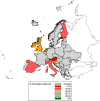Ending preventable stillbirths and improving bereavement care: a scorecard for high- and upper-middle income countries
- PMID: 37391688
- PMCID: PMC10311809
- DOI: 10.1186/s12884-023-05765-5
Ending preventable stillbirths and improving bereavement care: a scorecard for high- and upper-middle income countries
Abstract
Background: Despite progress, stillbirth rates in many high- and upper-middle income countries remain high, and the majority of these deaths are preventable. We introduce the Ending Preventable Stillbirths (EPS) Scorecard for High- and Upper Middle-Income Countries, a tool to track progress against the Lancet's 2016 EPS Series Call to Action, fostering transparency, consistency and accountability.
Methods: The Scorecard for EPS in High- and Upper-Middle Income Countries was adapted from the Scorecard for EPS in Low-Income Countries, which includes 20 indicators to track progress against the eight Call to Action targets. The Scorecard for High- and Upper-Middle Income Countries includes 23 indicators tracking progress against these same Call to Action targets. For this inaugural version of the Scorecard, 13 high- and upper-middle income countries supplied data. Data were collated and compared between and within countries.
Results: Data were complete for 15 of 23 indicators (65%). Five key issues were identified: (1) there is wide variation in stillbirth rates and related perinatal outcomes, (2) definitions of stillbirth and related perinatal outcomes vary widely across countries, (3) data on key risk factors for stillbirth are often missing and equity is not consistently tracked, (4) most countries lack guidelines and targets for critical areas for stillbirth prevention and care after stillbirth and have not set a national stillbirth rate target, and (5) most countries do not have mechanisms in place for reduction of stigma or guidelines around bereavement care.
Conclusions: This inaugural version of the Scorecard for High- and Upper-Middle Income Countries highlights important gaps in performance indicators for stillbirth both between and within countries. The Scorecard provides a basis for future assessment of progress and can be used to help hold individual countries accountable, especially for reducing stillbirth inequities in disadvantaged groups.
Keywords: Accountability; Bereavement; Data; Equity; High-income countries; High-resource setting; Performance indicators; Scorecard; Stigma; Stillbirth.
© 2023. The Author(s).
Conflict of interest statement
VF is the Director of the Centre of Research Excellence in Stillbirth (Stillbirth CRE) funded through the Australian National Health and Medical Research Council, and a Board member of the International Stillbirth Alliance (ISA). SHL, MM, PQ and AV are a Board member of ISA. The other authors have no competing interests to disclose.
Figures




References
-
- World Health Organization . International Statistical Classification of Diseases and Related Health Problems (ICD), 11th Revisions (ICD-11) 2022.
-
- UNICEF, WHO, World Bank Group, United Nations. Never Forgotten: The situation of stillbirth around the globe: Report of the United Nations Inter-agency Group for Child Mortality Estimation, 2022. United Nations Children’s Fund. 2023. https://data.unicef.org/resources/never-forgotten-stillbirth-estimates-r....
MeSH terms
Grants and funding
LinkOut - more resources
Full Text Sources
Medical
Miscellaneous

